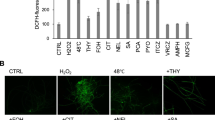Abstract
In a survey of antifungal stress compounds induced by cupric chloride we found that leaves ofChenopodium album exuded a highly fungitoxic metabolite mucondialdehyde (trans-2,trans-4-hexadienedial), which was associated with 13-oxo-9,11-tridecadienoic acids (cis-9,trans-11 andtrans-9,trans-11 isomers) presumably resulting from β-scission of 13-hydroperoxy-octadecadi(tri)enoic acid. The biogenesis and role as a general defensive agent in plants are briefly discussed.
Similar content being viewed by others
References
Gerwick, W. H., Moghaddam, M. F., and Hamberg, M., Archs Biochem. Biophys.290 (1991) 436; Oxylipin is introduced as an encompassing term for oxygenated compounds which are formed from fatty acids by reaction(s) involving at least one step of mono or dioxygenase-catalyzed oxygenation. As such, this term includes the eicosanoids as well as biosynthetically related compounds of longer and shorter chain length.
Kato, T., Yamaguchi, Y., Namai, T., and Hirukawa, T., Biosci. Biotech. Biochem.57 (1993) 283.
Vernenghi, A., and Ravisé, A., Can. J. Bot.64 (1986) 973.
Croft, K. P. C., Jüttner, F., and Slusarenko, A. J., Pl. Physiol.101 (1993) 13.
Vick, B. A., and Zimmerman, D. C., in: The Biochemistry of Plants Vol. 9, p. 53. P. K. Stumpf and E. E. Conn. Academic Press, Orlando 1987.
Siedow, J. N., A. Rev. Pl. Physiol. Pl. Molec. Biol.42 (1991) 145.
Hatanaka, A., Kajiwara, T., and Sekiya, J., Chem. Phys. Lipids44 (1987) 341.
Homans, A. L., and Fuchs, A., J. Chromat.51 (1970) 327.
Saito, K., Kozaki, M., and Takahashi, K., Heterocycles31 (1990) 1491.
Vick, B. A., and Zimmerman, D. C., Pl. Physiol.90 (1989) 125.
Ayers, A. R., Ebel, J., Valent, B. S., and Albersheim, P., Pl. Physiol.57 (1976) 760.
Murashige, T., and Skoog, F., Pl. Physiol.15 (1962) 473. The suspension culture ofC. albus was raised from a callus initially dedifferentiated from the seedlings, and grown at 27°C on a shaker in 500-ml shaking flasks containing 250 ml of MS medium; (sucrose, 3%; kinetin, 0.1 ppm; and 2,4-D, 2 ppm). The cells cultured for 2 weeks were stressed by the addition of CuCl2 (1.5 mM) and another two days incubation, at which point the filtered medium was extracted to give stress metabolites.
Bonner, J., and Galston, A. W., Bot. Gaz.106 (1944) 185.
Abdul-Wahab, A. S., and Rice, E. L., Bull. Torrey Bot. Club94 (1967) 486.
Garssen, G. J., Vliegenthart, J. F. G., and Boldingh, J., Biochem. J.122 (1971) 327.
Chamulitrat, W., and Mason, R. P., Archs Biochem. Biophys.282 (1990) 65.
Salzmann, U., Künn, H., Schewe, T., and Rapoport, S. M., Biochim. biophys. Acta795 (1984) 535.
Andrianarison, R.-H., Beneytout, J.-L., and Tixier, M., Pl. Physiol.91 (1989) 1280.
Hamberg, M., Adv. Prostaglandin, Thromboxane, Leucotriene Res.21A (1990) 117.
Gafarova, T., Grechkin, A., and Tarchevskii, I., in: Proc. 9th Int. Symp. Plant Lipids, p. 301. Eds P. J. Quinn, and J. L. Harwood. Portland Press, London 1990.
Lam, B. K., Lin, Y.-L., Ho, H.-Y., and Wong, P. Y.-K., Biochem. biophys. Res. Commun.149 (1987) 1111.
Vaz, A. D. N., Roberts, E. S., and Coon, M. J., Proc. natl Acad. Sci. USA87 (1990) 5499.
Bernart, M. W., Whatley, G. G., and Gerwick, W. H., J. Nat. Prod.56 (1993) 245.
Zeringue, H. J. Jr. Phytochemistry31 (1992) 2305.
The presence of mucondialdehyde was confirmed in the exudates from many plants stressed with a cupric chloride solution by TLC, TLC bioautography and/or GC-MS in comparison with an authentic compound. A further survey of stress compounds revealed that 6-hydroxy-trans-2,trans-4-hexadienal was produced byHypochoeris radicata L. (Compositae) in addition to mucondialdehyde. The results (Y. Maruta et al.) will be published elsewhere.
Author information
Authors and Affiliations
Rights and permissions
About this article
Cite this article
Tahara, S., Kasai, S., Inoue, M. et al. Identification of mucondialdehyde as a novel stress metabolite. Experientia 50, 137–141 (1994). https://doi.org/10.1007/BF01984952
Received:
Accepted:
Published:
Issue Date:
DOI: https://doi.org/10.1007/BF01984952




